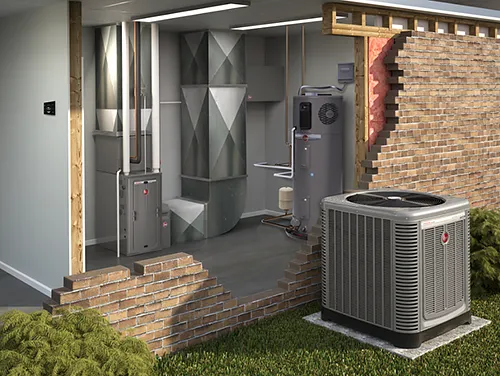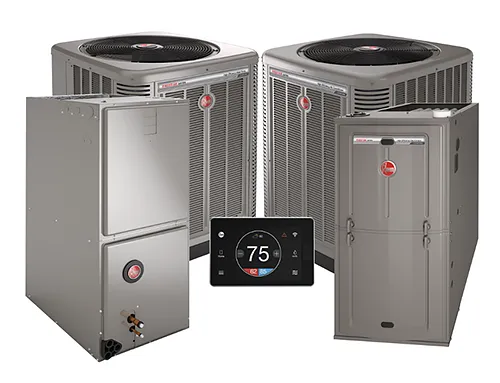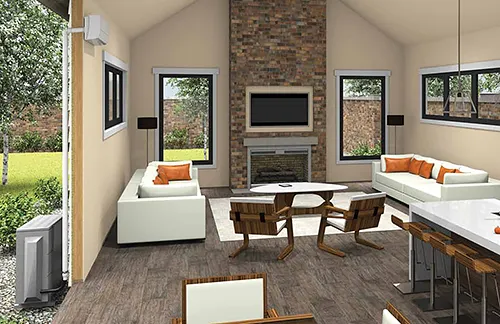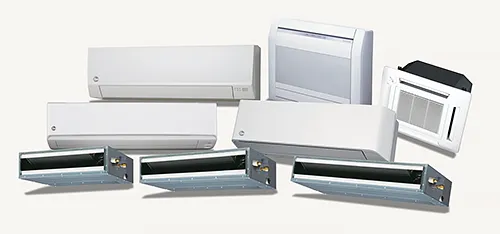Choosing the Right HVAC System
When you shop for new home products, it’s easy to get drawn to the things you see every day. Don’t overlook the internal mechanisms that keep your house healthy and comfortable! Your HVAC (heating, ventilation, and air conditioning) system is a critical part of your home and will affect your day-to-day experience as well as your utility bills through the years. Here’s how the major options compare!

Conventional HVAC vs. Heat Pumps
In-home climate control has come a long way from relying on fireplaces and windows. In just a few centuries, houses moved from coal-burning stoves to steam-heating radiators to electric baseboard heating. The majority of modern homes use central HVAC systems now, which force hot air from the furnace or cool air from the air conditioner through ductwork to adjust the temperature of the interior to match the set thermostat.
If you opt for a conventional HVAC system, you have to decide what kind of furnace to use. Most homes in the United States use natural gas as their heating fuel, but propane, oil, and electric heating are also common in some areas. Be sure to check availability and cost—they vary widely depending on infrastructure and the source of your municipal energy—and invest in the best furnace for the long haul. Oil and gas models burn fuel to heat the air moving through the system while electric furnaces run a current through resistance coils to achieve the same ends. Due to the different qualities of oil, gas, and electricity, you can expect maintenance needs and costs to vary; regular upkeep keeps systems operating efficiently and prolongs the life of the unit, so it is an investment that will save money over time.
No matter where you live, your air conditioner will use electricity. It doesn’t use it to create cold air like a furnace generates heat, though. An air conditioner transfers heat from inside to the outdoors. Refrigerant absorbs heat and becomes a gas, then it releases that heat outside when it passes through the condenser. The refrigerant cycles through the system in liquid and gaseous states to cool—or remove heat from—the air inside as long as the AC is running.
A newer invention, a heat pump performs the jobs of the furnace and air conditioning unit in one. It’s actually constructed almost exactly like an air conditioner with its coils and compressor (pictured right: a heat pump on the left and an AC unit and gas furnace on the right). The key difference is that it can be reversed. The reversing valve changes the flow of refrigerant, so it absorbs heat from outside and releases it inside when you need to warm the interior. It sounds counterintuitive that you can take heat from outside when it’s cold, but the temperature outside is warmer than the temperature of the refrigerant, so it actually does heat up!
So, which is better—an HVAC system that includes a furnace and AC unit, or an all-in-one heat pump? It depends on a few factors. Heat pumps are more energy efficient than conventional systems—there’s no fuel to burn, remember—but the air-source models that are common for residential use lose efficiency when it’s very cold outside because they have to work harder to condense heat. For this reason, homes at higher latitudes often have a supplementary heating system or opt for a furnace and regular AC. Of course, some people are more comfortable with the thing they know, and today’s HVAC appliances are significantly more efficient than ones in the past, so you can’t go wrong. Discuss the options with a local professional—their experience with different systems in your actual area can get you pointed in the best direction more quickly.

Central vs. Mini-Split Systems
Most homes in the United States feature central HVAC, where the heated/cooled air is circulated through ductwork and blown through air registers around the house. Everything is controlled with a central thermostat that tells the system what needs to be done to achieve the desired temperature. Conventional HVAC and heat pumps can both work as central systems, but only heat pumps are available in zoned mini-split systems.
 Despite their relative unfamiliarity here, mini-split systems are actually the preferred choice across much of Europe and Asia. They are ideal for renovating older houses because they don’t require ductwork—refrigerant is cycled from the exterior unit(s) to interior unit(s) through thin copper tubing to provide heating or cooling as needed. Mini-splits also make a great choice for new construction if you want to build an exceptionally efficient home that saves energy. It’s not just because they’re heat pumps—mini-splits offer a variety of ceiling-, wall-, and floor-mounted units (pictured right) so each room gets its own climate control. If you don’t use your bedrooms during the day or your living spaces at night, why waste energy? Adjust the interior units to provide heating or cooling where you need it! A mini-split system gives you more control—you can tailor how you use it to optimize efficiency room-by-room.
Despite their relative unfamiliarity here, mini-split systems are actually the preferred choice across much of Europe and Asia. They are ideal for renovating older houses because they don’t require ductwork—refrigerant is cycled from the exterior unit(s) to interior unit(s) through thin copper tubing to provide heating or cooling as needed. Mini-splits also make a great choice for new construction if you want to build an exceptionally efficient home that saves energy. It’s not just because they’re heat pumps—mini-splits offer a variety of ceiling-, wall-, and floor-mounted units (pictured right) so each room gets its own climate control. If you don’t use your bedrooms during the day or your living spaces at night, why waste energy? Adjust the interior units to provide heating or cooling where you need it! A mini-split system gives you more control—you can tailor how you use it to optimize efficiency room-by-room.
No matter which direction you choose to go with your HVAC appliances, you’ll find a surprising number of options available. There isn’t a one-size-fits-all solution—much of it depends on where you live and the size of your house. So, whatever your circumstances, be sure to take a look at Rheem®! With a wide variety of furnaces, air conditioners, and heat pumps and a global presence, you’re sure to find the perfect appliances for your HVAC needs.
BROWSE HOME PRODUCT ARTICLES
- Creating a Spa-Like Master Bathroom »
- Designing a Water-Efficient Bathroom »
- Design a Modern Bathroom »
- View All Bathroom Articles »
- Building a New Home »
- Building a Duplex »
- Finding the Right Home Builder »
- View All Building Tips Articles »
- Adding the Right Columns»
- Decorative Touches for Your Interior»
- Shutters for Every Architectural Style »
- View All Columns & Millwork Articles »
- How to Use Specialty Laminates »
- Decorative Touches for Your Home's Interior
- View All Countertops and Surfaces Articles »
- What Goes Into a Great Deck? »
- Decorative Touches for Your Home's Interior »
- View All Decking Articles »
- Choosing Glass for Your Entry »
- Stylish Personas for Your Front Door »
- Using Sidelites and Transoms »
- View All Door Articles »
- Choose Siding for Your Region »
- Get the Most Out of Exterior Paint »
- Mixing Siding to Define Your Exterior »
- View All Exterior Articles »
- Finding the Right Home Builder »
- The Appeal of Small House Plans »
- Choosing the Perfect Floor Plan »
- View All Finding a Home Plan Articles »
- Colorful Flooring for Your Home »
- Designing With Different Widths»
- Chic, Neutral, Gray Flooring »
- View All Flooring Articles »
- Garage Doors That Add Curb Appeal »
- Caring for Your Garage Doors »
- Benefits of Insulated Garage Doors »
- View All Garage Door Articles »
- Reclaimed Products for Your Home »
- Building a Green and Stylish Home »
- Benefits of Building with SIPS »
- View All Green Building Articles »
- Cool Gadgets for Your New Home »
- Creating a Hi-Tech Home »
- Efficient Gifts for New Homeowners »
- View All Home Electronics Articles »
- Improve Your Home's Air Circulation »
- How to Improve the Air Circulation in Your Home »
- View All HVAC Articles »
- Bedrooms Designed for Sleep »
- Selecting a Fireplace for Your Home »
- Crafting a Luxurious Master Suite »
- View All Interior Design Articles »
- Design the Perfect Outdoor Space »
- Dive into a Beautiful Pool »
- Design a Sizzling Outdoor Kitchen »
- View All Outdoor Living Articles »
- Apps to Help You Pick Paint Colors »
- Create the Perfect Mood with Paint »
- How to Read the Color Wheel »
- View All Painting & Decorating Articles»
- Creating a Spa-Like Master Bathroom »
- High-Impact Kitchen Upgrades »
- Creating a Water Efficient Bathroom »
- View All Plumbing Fixtures Articles»
- Cladding That Complements Your Exterior »
- Reasons to Consider Prefinished Siding »
- View All Siding & Cladding Articles»
- All About Solar Powered Skylights »
- Natural Lighting for the Dark Corners of Your Home »
- Design a Better Bedroom with Skylights »
- View All Skylight Articles»
.png)
.png)
